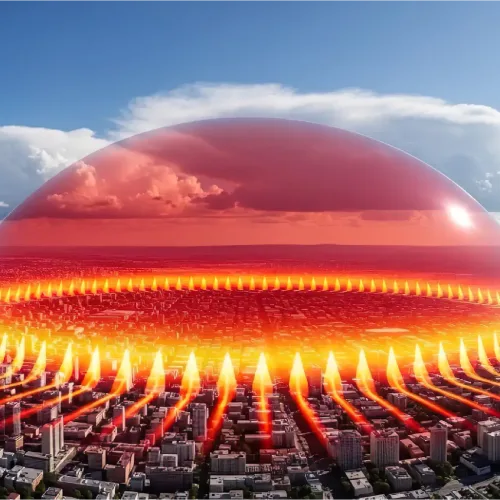Have you ever imagined a world where electricity flows seamlessly without any loss? Power stations run at 100% efficiency, and magnetic levitation trains travel effortlessly and smoothly. Certainly, this feels something out of a science fiction, but after the announcement of lk99, all of this might become possible. It is a material claimed to be the first room temperature superconductor.
Superconductors are materials capable of conducting electricity with zero resistance. However, conventional superconductors, as we know them, requires extremely low temperatures to work. They often work below -200 °C. South Korean researchers developed lk99 and claimed that it is capable of working at ambient pressure and temperatures up to 127 °C. Although these claims have created excitement, they’ve also generated skepticism because of issues of replication. In this article we will delve into the structure of lk99, its mechanism, potential applications, associated challenges, peer review, and much more. So, let’s get started.
The Crystal Structure Behind LK99’s Magic
LK99 is an artificially made material with lead-apatite structure with some modifications, i.e., lead phosphate compound, which is copper-doped, with chemical formula of Pb₁₀₋ₓCuₓ(PO₄)₆O. It is this unique crystal arrangement that gives the “magic” to its supposed superconductivity. In the pure state, lead-apatite is an insulator, but when you substitute the copper atoms for the lead atoms there is a small structural distortion, approximately 0.48% volumetric reduction. This distortion creates superconducting quantum wells at the interface of lead and phosphate layers, providing the possibility for electrons to move without any resistance.

News on the discovery was broken in July 2023 by a group led by Sukbae Lee and Ji-Hoon Kim from the Quantum Energy Research Centre in South Korea. Their results, as posted on arXiv, said lk99 shows room-temperature superconductivity at ambient pressures, catching international attention.
From Theory to Synthesis of LK99
Synthesizing lk99 involves precise steps: combining lead, copper, phosphorus, and oxygen in certain proportions, heating this mix, and crystallizing it until it takes the apatite structure and annealing it to stabilize the crystals. The task is to supply ideal copper doping, not enough and the substance remains a non-conductor. On the contrary, too much, and the structure collapses. Reproducibility is still a major issue as many labs could not replicate the results of the original work as pointed out in reports from nature.
How Does LK99 Break the Critical-Temp Barrier?
In superconductivity, a material can pass electricity without any resistance as it often comes with the Meissner effect, where the magnetic fields are eliminated causing levitation over magnetic attractors. Cooper pairs do this, they are groups of electrons which pair through lattice vibration (phonons) and travel without scattering. Conventional superconductors need to reach such high temperatures that can almost approach absolute zero levels to hold on to these pairs, but lk99 was purported to do this at room temperature, a feat that was considered impossible.
The mechanism is based on lk99’s copper-doped structure that forms quantum wells that increase electron pairing. As a result, it supports superconductivity at higher temperatures than 400 K. This ambient superconductivity, lk99 was said, could redefine materials science, saving it from the known pathetic state of being. However, fallen attempts at replication continue to elicit doubt.
Key Properties & Metrics
To confirm superconductivity, key metrics are measured:
- Critical Temperature (Tc): lk99’s Tc was claimed to exceed 400 K.
- Zero Resistivity: No electrical resistance below Tc.
- Critical Current (Ic): Highest current before superconductivity fails.
- Critical Magnetic Field (Hc): Magnetic field strength that disrupts superconductivity.
- Meissner Effect: Expulsion of magnetic fields, enabling levitation.
The first set of readings showed zero resistivity and partial levitation, but later on, the sort of readings reported on Ars Technica, suggest that these results may be due to impurities like copper sulfide, and not actual superconductivity after all. To better appreciate the significance of these claims, a table comparing these purported properties of lk99 with those of well-known superconductors would be informative.
| Material | Critical Temperature (Tc) | Pressure Need | Estimated Year of Discovery | Typical Applications |
|---|---|---|---|---|
| LK99 (Claimed) | ≥ 400 K (≥ 127 °C) | Atmospheric | 2023 | Power transmission, transportation, electronics |
| YBCO | ~93 K (~-180 °C) | Atmospheric | 1987 | High-field magnets, research |
| NbTi | ~9 K (~-264 °C) | Atmospheric | 1962 | MRI machines, superconducting magnets in accelerators |
Potential Applications of LK99
If lk99’s room-temperature superconductivity is confirmed, its uses can revolutionize several industries. In what follows, we discuss its potential impact.
Energy Efficiency
Applications of energy of the lk99 could reduce the losses of transmissions that are responsible for approximately 5% of electric power, according to the U.S. Energy Information Administration. The elimination of losses would be possible due to the superconducting power lines that conducted energy from remote sources of renewable energy to the cities. Superconducting magnetic energy storage (SMES) systems could store energy in magnetic fields without any losses to stabilize grids. In the fusor reactors, room-temperature superconducting magnets can make the process simpler in tokamak design, for clean energy, as covered in the IEEE Energy articles.
Transportation

In the area of transportation, lk99 can improve magnetic levitation (maglev) trains that use magnetic fields to reduce friction for transportation. The current maglev uses superconductors, cooled systems like in South Korea.
lk99 may manage to prevent this necessity thereby cutting costs and limiting complication, with possible world-wide propagation of maglev networks, the possibility of which goes against the grain of The Guardian.
Medical Technology
In the medical field, the new material could improve MRI machines, which use special magnets called superconductors. If these superconductors work at room temperature, they would reduce costs and make advanced medical imaging more available. This change could lead to more precise diagnoses and better outcomes for patients. It could also help create new medical devices that take advantage of the special properties of superconductors.
Electronics and Computing
LK99 is extensively used in electronics, including fields like ultra-efficient chips and quantum computing. According to the research on the IBM Quantum blog, superconducting logic gates have the potential to overpass silicon-based superconductors. However, room temperature superconductor qubits could revolutionize quantum computers.
LK99’s Impact on Research and Industry
If lk99 is found to be a useful superconductor at room temperature, it could lead to exciting new ideas and investments in many industries. Research centers and companies will quickly work on new technologies and uses, creating jobs, its replication efforts, and boosting the economy.
The discovery of lk99 could help countries investing in this technology become leaders in a new technological revolution. Moreover, scientists and engineers around the world could work together to speed up the development and use of technologies based on lk99.
This change could change the landscape of various industries, improving the way we live and work.
Challenges and Future Prospects
Lk99 faces a lot of challenges, with reproducibility being the most significant. Several laboratories, including Chinese Academy of Sciences, have identified it as an insulator with very limited superconducting capacity. Many claims were published as reprints without proper review, await rigorous validation.
The good news is that global research on the properties of lk99 is still ongoing. Scientists are working to improve its manufacturing techniques and are also exploring theoretical approaches to explain its behavior.
Conclusion
LK99’s ability to work as a superconductor at room temperature is exciting and could transform many areas of technology. If it works as expected, it could lead to huge improvements in energy use, transportation, medical technology, and electronics. Although there are still some challenges, the discovery of lk99 could trigger a new wave of technological innovation and economic growth. According to a peer review, researchers are actively studying the properties of lk99, and the world is paying close attention to what happens next. If successful, it could transform our technology and create new opportunities for generations to come.
What do you think about lk99’s potential? Share your thoughts in the comments. Which lk99 application excites you most? Stay engaged with this evolving story!




